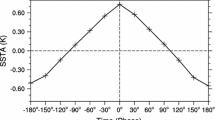Abstract
Rlationship between the Southern Hemisphere upper troposphere zonal wind variability and the East Asian summer monsoon was studied. The mean zonal wind difference in 150 hPa between 60°S and 30°S is defined as an index (ISH). The research reveals that ISH is negatively correlated with the East Asian summer monsoon (EASM) circulation in the interannual scale. It is also suggested that the meridional teleconnection in the zonal wind field, with the main part in Eastern Hemisphere, from mid-and-high latitudes in the Southern Hemisphere to the tropical region is responsible for the ISH-EASM link-age. The teleconnection may result in changes of the wind fields and pressure system changes causing variability of the East Asian monsoon. In addition, the anomalous teleconnection pattern in Eurasia is likely to be another mechanism. ISH and EASM circulation are found to have both simultaneous and lag correlations, thus, the relationship has implications for seasonal climate prediction over East Asia.
Similar content being viewed by others
References
Ju J, Slingo J M. The Asian summer monsoon and ENSO. Quart J Roy Meteor Soc, 1995, 121(525): 1133–1168
Wang B, Wu R, Fu X H. Pacific-East Asian teleconnection: How does ENSO affect East Asian climate? J Climate, 2000, 13(9): 1517–1536
Wang H J. The weakening of the Asian Monsoon Circulation after the end of 1970’s. Adv Atmos Sci, 2001(3), 18: 376–386
Wang H J. Instibility of the East Asian Summer monsoon-ENSO Relations. Adv Atmos Sci, 2002, 19(1): 1–11
Huang R H, Lu L. Numerical simulation of the relationship between the anomaly of the subtropical high in East Asia and the convective activities in the tropical western Pacific. Adv Atmos Sci, 1989, 6(2): 202–214
Shen X S, Kimoto M, Sumi A, et al. Matsumoto J, Simulation of the 1998 East Asian summermonsoon by the CCSR/NIES AGCM. J Meteo Soc Japan, 2001, 79(3): 741–757
Yang S, Lau K M. Influences of Sea Surface Temperature and Ground Wetness on Asian Summer Monsoon. J Climate, 1998, 11(12): 3230–3246
Xue F, Jiang D B, Lang X M, et al. Influence of Mascarene high and Australian high on the summer monsoon in East Asia: Ensemble simulation. Adv Atmos Sci, 2003, 20(5): 799–809
Xue F, Wang H J, He J H. Interannual variability of Mascarene high and Australian high and their influences on summer rainfall over East Asia. Chin Sci Bull, 2003, 48(5): 492–497
Wang H J, Xue F. The interannual variability of Somali jet and its influences on the inter-hemispheric water vapor transport and the East Asian summer rainfall. Chinese J Geophys, 2003, 46(1): 11–20
Fan K, Wang H J. Antarctic oscillation and the dust weather frequency in North China. Geophys Res Lett, 2004, 31, L10201, doi:10.1029/2004GL019465
Gong D Y, Wang S W. Definition of Antarctic Oscillation index. Geophys Res Lett, 1999, 26: 459–462
Thompson D W J, Wallace J W, Hegerl G C. Annular modes in the extropical circulation. Part II: Trends. J Climate, 2000, 13(5): 1018–1036
Thompson D W J, Solomom S. Interpreation of recent Southern Hemisphere climate change. Science, 2002, 296(5569): 895–899
Marshall G J. Trends in the southern annular mode from observations and reanalysis. J Climate, 2003, 16(24): 4134–4143
Marshall G J, Stott P A, Turner J, et al. Causes of exceptional atmospheric circulation changes in the Southern Hemisphere. Geophys Res Lett, 2004, 31, L14205, doi:10.1029/2004GL019952
Wang H J, Fan K. Central-north China precipitation as reconstructed from the Qing dynasty: Signal of the Antarctic Atmospheric Oscillation. Geophys Res Lett, 2005, 32, L24705, doi:10.1029/2005GL024562
Kiladis G N, Mo K. Interannual and intraseasonal variability in the Southern Hemisphere. In: Karoly D J, Vincent D G, eds. Meteorology of the Southern Hemisphere. Amer Meteor Soc, 1998: 307–336
Nigam S. On the structure of variability of the observed tropospheric and stratospheric zonal-mean zonal wind. J Atmos Sci, 1990, 47(14): 1799–1813
Watterson I G. Southern Mid-latitude Zonal Wind Vacillation and Its Interaction with the Ocean in GCM Simulations. J Climate, 2000, 13(3): 562–578
Author information
Authors and Affiliations
Corresponding author
About this article
Cite this article
Wang, H., Fan, K. Southern Hemisphere mean zonal wind in upper troposphere and East Asian summer monsoon circulation. CHINESE SCI BULL 51, 1508–1514 (2006). https://doi.org/10.1007/s11434-006-2009-0
Received:
Accepted:
Published:
Issue Date:
DOI: https://doi.org/10.1007/s11434-006-2009-0




